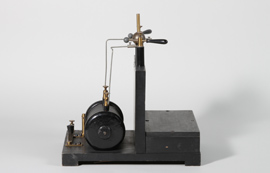|
100 Years of Research and Development: An Historical Overview in plain English
Franz Pichler
The exhibition CAR CULTURE & the Media of Mobility, currently on show at the ZKM | Centre for Art and Media in Karlsruhe, aims in part to present the historical, technical development of the medium of the mobile telephone and the network in which it operates. Heinrich Hertz's experiments with the transmission of electromagnetic waves from a sender to a receiver, successfully conducted at the Technical University of Karlsruhe in 1887, can be viewed here as the birth of this developmental process. It was a long road from Heinrich Hertz's experiments to the cellular mobile communications networks in place today and all of the mobile phones of the individual users connected to them. The following text describes the most important milestones of this development in more detail.
1. Electricity and Electrodynamics
1.1 An Overview of the Historical Developments
Electricity can be regarded as one of the most important, technically implementable phenomena that Nature offers us. Without electricity, the way we live today, in our civilized societies, would no longer be conceivable. Electricity's physical properties weren't researched in depth until the 18th and 19th centuries. The great experimental discoveries in the field of electricity - such as Heinrich von Kleist's Leyden jar (1745), Luigi Galvani's experiments with frog legs (1791), Alessandro Volta's discovery of the voltaic cell (1800), Hans Christian Ørsted's discovery of the magnetic field of an electrical current (1820), and the discovery of induction by Michael Faraday (1831) - were followed by a theoretical and mathematical understanding of the electrical effects which these experiments revealed. Of particular note in this context are the publications by André-Marie Ampère (1821) and Wilhelm Weber (1846), each of which established a fundamental law for the force effects of stationary and moving electrical charges in mathematical form. Their findings became the origin of the field of electrodynamic research, a branch of electrical theory that is still of great importance today.
[Abstract of the exhibition catalogue: CAR CULTURE. Medien der Mobilität]
|
|

Chiffriermaschine CD-57 (Hagelin)
Krypto AG Zug, Schweiz, 1957
Foto: Anatole Serexhe

Verschlüsselungsmaschine M209
US Army
Foto: Anatole Serexhe

Marconi Funkensender
(Schulmodell)
Foto: Anatole Serexhe
|